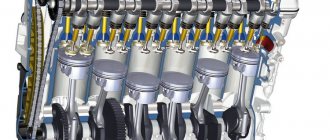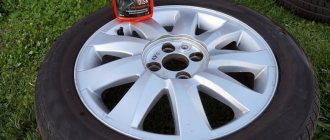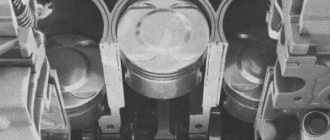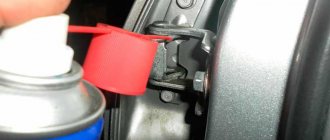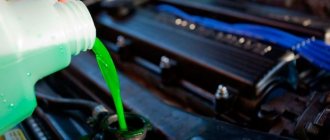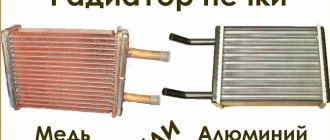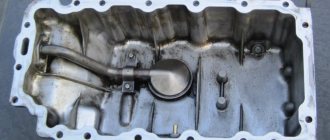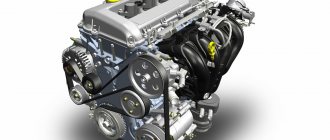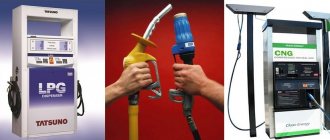Compositions of the brand "Abro"
This brand produces several products: a cleaner and a foam cleaner. In the first case, the container costs about 130 rubles and weighs 510 grams, in the second - 120 rubles and weighs 453 grams.
These are almost identical products with different packaging designs. Both compositions have the same font. However, there is a significant difference in the instructions. The foam cleaner must be shaken before use. The second product must be sprayed at a distance of 30 centimeters so that it does not come into contact with the paintwork. It's worth noting that both cleaners foam.
The compositions work the same way. After application from a short distance, a fairly abundant foam is formed, which slowly settles. The jet is also clearly visible. This will allow you to direct it to the right place.
As for the effect, many consumers praise these cleaners in their reviews. Both formulations work well on oil and brake fluid stains. Road dirt is also partially dissolved. It is worth noting that both compositions are easily washed off with water with a gentle stream. You can use a brush to remove any remaining road dirt. Cleaners do not cause any unpleasant sensations when they come into contact with the skin and are easily washed off. When using, there is a slight smell of kerosene.
CONSUMER ANALYSIS
FEATURES: the cleaner is more suitable for small service and repair stations than for a specific car enthusiast, this is supported by the large volume of the final solution: 9-15 liters, and the need to purchase an additional sprayer. The mechanism of action of the drug is also interesting: it must be applied to a hot engine (the cleaner does not support combustion), because the maximum effectiveness of the composition is achieved during its boiling, the temperature of which is approximately 80°C. Correctly selected engine temperature can be determined by abundant foam on the surface being cleaned.
During the test, we used a 40% concentrate solution; after the product interacted, it was not removed with a high-pressure apparatus, but simply rinsed with water, just like other products. On the test sample, the drug showed cleaning abilities slightly below average, but, of course, its effectiveness is the best among the foam cleaners of the participants in our testing.
SUMMARY
ADVANTAGES: large volume of final solution, fire safety of the composition.
DISADVANTAGES: need to purchase a sprayer, average efficiency of 40% solution.
GENERAL ASSESSMENT: the scope of application of this drug is small car services or car washes, this is indicated by the volume of the final solution and its operation on a hot engine. And those contaminants that did not respond to the cleaner will be washed off with a high-pressure apparatus.
Washing technique
To begin with, it is worth preparing the power unit for cleaning procedures. This is done by isolating areas that should not have contact with water. So, before washing the engine, you need to seal the air filter, battery pack, terminals and other areas with electrical connections with tape and polyethylene.
Next, you can apply the composition. Depending on the volume of cleaning mass, a brush or rag of a certain size may be required. It is usually not recommended to apply a large volume of cleaning mass at once - as you rub with a brush and dilute with water, foam is produced that covers a much larger area. In the question of how to wash the engine, its temperature is also important. The optimal mode from the point of view of dirt removal efficiency is considered to be 50-80°C, but not all preparations support the possibility of contact with hot surfaces.
Types of cleaners
Today, the market offers consumers several types of products for cleaning car air conditioning:
- aerosol substances,
- foam products,
- smoke bombs.
Photo gallery “Types of cleaners”
1. Aerosol Klima fresh plus from Liqui Moly
2. Step Up foam cleaner with hose
3. Smoke bombs Air conditionar deodorant steam
It must be said right away that the use of these substances is only relevant if the contamination of the air conditioning system is not severe. If you want to completely remove all dirt and deposits from the system, you will have to dismantle and clean the filters, as well as the evaporator unit. Let's take a closer look at all types of funds.
Aerosols
Aerosol cleaners for air conditioning are the best option for preventing the system, as well as removing minor contaminants.
Let's consider several branded aerosols:
- Aerosols from Liqui Moly, in particular, we are talking about the Klima fresh plus product. This substance allows you to remove dirt from the lines of the air conditioning system, as well as eliminate fungus.
- Lokit Spray from the Henkel brand. This substance belongs to the type of hygienic cleaning products; according to the manufacturer, this aerosol is the most effective. It’s logical, because what manufacturer wouldn’t praise their product? In fact, the product can remove all harmful elements, bacteria and fungi. In addition, its use will eliminate the stench that collects in the cabin. In addition, this substance has a pleasant menthol smell.
- XADO sprays. Antibacterial substances from this manufacturer have long occupied their niche in the domestic market. This product allows you to effectively remove small amounts of dirt, as well as saturate the car interior with the smell of eucalyptus.
- We couldn't ignore Mannol air-con fresh. This substance is considered antibacterial and can be used to quickly clean the unit. According to the manufacturer, to use this aerosol you do not need to remove the cabin filter. But as with other products, Mannol air-con fresh is best used for preventive purposes.
Cleaning the unit using an aerosol
Foam cleaners
Foam cleaners are a better option if your air conditioning system requires in-depth cleaning. As practice shows, almost any foam car air conditioner cleaner is a more effective option than an aerosol.
The most popular foam cleaners among our compatriots are:
- First place goes to Step Up. This product is manufactured in the USA, so there is no doubt about its quality. As you know, almost all goods produced overseas have certified quality documents. As for Step Up, this cleaner has collected the largest number of positive comments from our compatriots on the Internet.
- Liqui Moly. The products of this brand are characterized by high quality, this also applies to foam cleaners.
- Runway. This cleaner also showed itself on the positive side. Its use is allowed both for preventive purposes and to remove serious dirt, fungus and unpleasant odors.
Smoke bombs
Smoke bombs are a relatively new option that appeared on sale not so long ago.
Among the most popular manufacturers, we highlight the following:
- Air conditioner deodorant steam. These checkers are used to remove harmful and unpleasant odors, as well as eliminate harmful bacteria and microorganisms from the unit.
- Cigarette deodorant steam type. Such checkers must be used to remove tobacco odor. As reviews show, this option is the most effective for those cars in which there is a lot of smoking.
- Carmate. Judging by consumer comments, checkers from this brand are considered one of the most effective, especially since they are easy to use. This manufacturer, by the way, offers many other products for cleaning condensers (author of the video channel Romanautoreview).
Lavr Foam Motor Cleaner
Price: 218 rub.
A composition designed not just for a single cleaning of the engine compartment of a car, but for regular use. The product from the Russian manufacturer is designed to maintain the cleanliness of internal combustion engine parts and protect them from the influence of harmful substances.
After applying this product, brushing the area to be cleaned is not required; the composition does not leave behind any traces of grease. It also does not pose a danger to engine components - moreover, it protects metal parts from corrosion. If you follow the instructions, the algorithm for using the cleaner will be as follows:
- the engine warms up approximately to the temperature it reaches when the car is driven;
- the motor air duct and the electronics of the unit are covered with waterproof material;
- the composition is sprayed onto the cleaning site;
- you should wait 3-5 minutes, maybe a little more;
- foam is washed off from the engine with powerful water pressure;
- previously installed protective materials are removed.
Based on the results of practical application, the composition from Lavr can be recommended to car enthusiasts for private use. This engine cleaner will also be useful when preparing your car for sale.
Conclusion
The list of commercially available engine cleaning products could be continued, and it is quite difficult to select the most optimal one among them. And whether it is necessary to wash the engine at all - there are different opinions on this matter. After all, during such maintenance, it is no wonder that the internal parts of the internal combustion engine will be flooded or its electronics damaged.
In principle, the power plants of modern cars are not as susceptible to contamination compared to those installed on older cars. Although both require at least minimal care.
Do-it-yourself car engine washing:
Why is this necessary?
In addition to the purely aesthetic side of the issue, washing the engine also has very practical purposes.
The duration of uninterrupted operation of the engine directly depends on its cleanliness. Oil deposits contribute to its regular overheating. Cooling, of course, works diligently to prevent the heat from getting too high, causing constant overload to wear out quickly. This means premature repairs and the risk that the cooling system will fail while on the road and far from the service station.
The fire hazard of an unwashed engine increases significantly: an accidental spark can ignite the oil fumes on the lid.
You should not wash too often; too much in this matter can also cause harm. But once every six months you definitely need to refresh the heart of your car.
Should you wash your car engine?
Most experts and experienced car owners agree that the engine needs to be washed on a regular basis, since dirt and oily deposits accumulated on its surface lead to overheating, which impairs the performance of the engine and can even lead to serious damage, the elimination of which will require time and money. .
Dirt accumulated on the engine and nearby parts contributes to corrosion of the power unit. This is especially true during active vehicle use in winter , when the roads are generously sprinkled with reagent. Subsequently, such chemistry gets onto the engine along with dirt and leads to the formation of corrosion.
Types and features of air conditioner cleaners
Before proceeding directly to the review of popular products for cleaning car air conditioning, it is worth familiarizing yourself with their types and features of use. So, currently on the shelves of auto stores you can find the following types:
Using a foam cleaner
- foamy;
- aerosol;
- smoke bomb.
Despite their diversity, they work on a similar principle. In particular, the active substance, regardless of its state of aggregation, is placed inside the air conditioner (on the evaporator), after which the system is turned on. This cleans the car air conditioner from bacteria, dust and dirt. However, to improve the effect, it is better to dismantle the evaporator and wash it separately. Do not forget also that it is recommended to change the cabin filter at least once a year. Cleaning your air conditioner is a great time to replace it accordingly.
Perhaps the most effective, and therefore the best, air conditioner cleaner is a foam one. This is achieved due to the fact that thick foam (from almost any product, regardless of brand) penetrates the tubes and cavities of the automobile air conditioning system, thereby removing all dust, dirt and germs. Aerosol cleaners are less effective, although there are some good ones among them.
It is worth mentioning the so-called smoke bombs. They are intended primarily for disinfection. After activating the checker, hot smoke containing quartz begins to intensively come out of it
Please note that such cleaning must be carried out when there are no people and/or animals in the cabin! The cleaning procedure takes about 8...10 minutes. After this, the interior must be thoroughly checked
Detailed operating instructions are usually printed on the package body or additionally printed on the attached sheet. However, in most cases, the algorithm for using air conditioner cleaners is similar and consists of the following steps:
Cleaning the air conditioner
- remove the cabin filter;
- Apply cleaner to the air conditioner evaporator (as thoroughly as possible, on all sides);
- close the filter element plugs;
- raise the car windows and close the doors;
- turn on the stove at maximum speed, but do not turn on the air conditioner, but set it to air recirculation mode;
- Also add air conditioning cleaner to the drainage hole, and its residues may flow out;
- wait the time specified in the instructions (usually up to 10...15 minutes);
- turn on the stove in heating mode in order to dry the interior;
- open the car windows and/or doors for ventilation;
- Reinstall the cabin filter (preferably a new one);
- make sure the air conditioner is working.
In some cases (if it is heavily soiled), the air conditioner can be cleaned twice. In case of very heavy contamination, when traditional cleaners do not help, it is necessary to perform mechanical cleaning of the device. To do this, it is better to contact a service station or a specialized car service.
Ordinary chemicals are prohibited
Car owners are very tempted to use everyday household chemicals to wash their engines.
Indeed, Fairy and other dish gels that we all know well can easily remove oily stains, but these liquids cannot ensure complete cleaning of the engine. Remember also that any DIY car engine cleaner will not be as effective as good store-bought chemicals. The problem is that laundry detergents and dish soaps can contain various flammable ingredients. Subsequently, some of these components remain on the engine and can lead to a fire in the engine compartment , which makes the vehicle unsafe to operate. That is why it is not recommended to save on car operation and purchase special auto chemicals; they are inexpensive, and such engine washing is carried out once or twice a year, so the consumption of the cleaner will be minimal.
What else can you treat tires with?
If for some reason you do not want or cannot buy a factory-made tire cleaner, then there are several “folk” remedies that can be used to treat the rubber surface of the tire. They also provide good efficiency in cleaning and protecting their surface.
Typically, in artisanal conditions, tires are treated in two stages - first they are washed, and then they are treated with a preservative compound. As a detergent, we can recommend any product that is safe for rubber and plastic, that is, does not contain solvents. The simplest thing is laundry soap, dishwashing detergent, washing powder, and so on (naturally, they should not be used in their pure form, but first dissolved in water; the proportion depends on the degree of contamination). You need to wash the tire by treating it mechanically using a rag, a brush and/or water pressure, but not too much, so as not to damage the rubber
Please note that you should not use window cleaners on tires, as most of them contain alcohol. They make the rubber loose and can reduce its service life, up to complete unsuitability (especially important for tires with high mileage or simply old products)
As for other factory products, plastic cleaners can also be used to clean and treat rubber. They are safe for rubber surfaces, and many of them are universal and are intended, among other things, for processing rubber.
Silicone grease is also ideal for treating the side surfaces of rubber tires. It will not only reliably protect the surface of the tire from harmful factors, but will also give it a beautiful appearance. By the way, factory tire cleaners are also made based on silicone oils, but with the addition of some other chemical compounds.
If you do not want to use factory-made products for blackening tires, then you can use a solution of two components - glycerin and water, mixed in proportions 1:1. This composition must be applied from a spray bottle to clean, dry wheels and allowed to dry. The result is quite good, although not as durable as factory products. However, given its cheap cost, this recipe is highly recommended as a replacement for professional tire cleaners.
Conclusion
The use of tire cleaners will not only ensure the pristine appearance of tires in the long term, but will also give them the necessary protection from negative external factors - chemicals, salt, minor mechanical damage, ultraviolet radiation, temperature changes and others. Therefore, if possible, buy a tire cleaner for your collection of automotive chemicals. It will extend the life of the tires, thereby reducing the budget spent on vehicle maintenance.
Laurel engine flushing, instructions, features of use
Do-it-yourself interior dry cleaning products and tools Let us immediately note that there are a large number of solutions for flushing the lubrication system on the open market: Liqui Moly, Lavr, Xado, Hi-Gear, etc. You can also find so-called flushing oil, while in the Russian Federation drivers usually choose Lukoil or Zic.
Given such diversity, we decided to focus on one of the most widely represented and most popular products among engine flushes. We are talking about products under the Lavr brand.
As you can see, the most convenient and widespread is a preparation for flushing the oil system, which:
- poured directly into the mining;
- does not react dangerously with motor oil;
- maintains the required oil viscosity when flushing;
- effectively removes sludge and other deposits;
- does not have a pronounced negative effect on oil seals and seals;
First of all, although manufacturers of washes claim that their formulations do not affect the oil itself and simply improve its cleaning ability, in fact this is not the case. In practice, oil dilution still occurs. This means that you cannot load the engine while using flushing, that is, the unit should only operate at idle. Otherwise, reduced viscosity can lead to accelerated wear and engine failure.
As for the LAVR line of engine oil flushes, experts took this feature into account. As a result, the wash contains a so-called viscosity corrector. In fact, it is a polymer included in the composition that prevents severe liquefaction.
If we talk about the Laurel line of cleaners and rinses, we should highlight the following products:
- Lavr “Classic” five-minute wash for cars and trucks, as well as other types of commercial vehicles. There is also a more intensive 7-minute washing of the Lavr engine.
- Soft flushing of the Lavr engine, designed for the internal combustion engine to be operated under moderate load for 150-200 km.
For a number of reasons, drivers often choose LAVR Motor Flush Soft 200 km. Its main difference is that you can drive with such a wash, it does not evaporate, and it also removes dirt more effectively than 5 and 7-minute “fast” compounds.
In other words, the mild oil system cleaner Lavr allows you to clean the engine for several days over 200 km, being an alternative to flushing oil. In this case, the internal combustion engine is operated under moderate loads during flushing.
LAVR Motor Flush Soft properties and practical test
So, the Motor Flush Soft detergent additive, better known as “soft flushing,” is poured into the engine lubrication system 150 or 200 km away. until the oil change is scheduled. One “portion” of this drug is enough to flush the lubrication system of such an engine, into which 4 to 6 liters are poured. oils
According to the manufacturer, washing delicately removes varnish and bitumen deposits, dissolves thickened gel-like contaminants, etc. At the same time, the presence of dispersants in the flushing composition protects the engine from wear and also helps prevent clogging of the oil system channels, oil receiver mesh and oil filter. Flushing also restores the elasticity of rubber seals and gaskets; the composition is compatible with all types of motor oils.
Let's move on to using LAVR Motor Flush Soft. According to the instructions, the first step is to warm up the engine until it reaches operating temperatures. Next, the flushing is poured into the oil filler neck. After this, the motor should run in XX mode for about 5 minutes.
Then you can drive the car without increasing the speed above 3 thousand, avoiding driving under tension, driving in high gears at low speed, etc. Maximum after 200 km. you need to drain the waste from the engine, replacing the oil and oil filter.
It turns out that you can travel up to 200 km. after adding it to mining it is highly undesirable. In simple words, it is optimal if the engine “travels” these kilometers in the form of engine hours, that is, idling.
What types of cleaners are there?
Currently, the range of car engine surface cleaners is quite wide. Similar products are produced by various manufacturers in different countries of the world. As for the physical state of cleaners, you can find three types of them on the shelves of car dealerships:
- aerosols;
- manual triggers;
- foam products.
According to statistics, aerosols are the most popular. Their popularity is due not only to their high efficiency, but also to their ease of use. So, they are applied to places of contamination using aerosol cans in which they are packaged (after hitting the surface, the active agent turns into foam). As for trigger packs, they are similar to aerosol packs, but the trigger involves manually spraying the cleaner onto the surface to be treated. Foam engine cleaners are applied using a rag or sponge and are designed to remove stains of oil, dirt, fuel, antifreeze and other technical fluids that may occur on the surface of engine compartment parts.
In addition to the type of packaging, engine cleaners differ in composition, in particular, in the base component. In large quantities, dodecylbenzenesulfonic acid (abbreviated DBSA) is used as the main detergent - a powerful synthetic emulsifier of oils and fats, capable of removing even dried substances from the surface it treats.
What is not recommended for washing?
As already noted, a certain effect can be achieved with the help of ordinary cleaning solutions; another thing is that they are more likely to exhaust the driver himself than to completely rid the surface of dirt. But if this option is acceptable in principle, then diesel and gasoline are even prohibited from being used for such purposes. This is especially true for the second type of fuel, since even the slightest spark will be enough to ignite. Diesel is completely useless as an engine cleaner and is more likely to only make the situation worse.
Popular concentrates
In addition to ready-to-use glass cleaners, you can find so-called concentrates on sale, that is, products that must first be diluted with water. This is done, firstly, to save money (since the amount of ready-made and usable cleaner will be larger, and its price will be lower), secondly, to regulate the cleaning ability, and thirdly, for the convenience of using such preparations in professional car washes, where they are used in large quantities.
Let us give, as an example, several popular concentrates that are recommended for purchase by car washes and various craftsmen, including car washes on a professional basis.
Liqui Moly Scheibeh-Reiniger-Super-Konzentrat. In everyday life it is also known as Liqui Moly super concentrate. Sold in a 250 ml bottle. Diluted in a ratio of 1:100. The kit includes a 25 ml dispenser, which makes it easier to work with. Real tests have shown that the cleaner copes well with even the most contaminated areas. In particular, it can be used to easily wash away dried insect residues, dust, dirt, wax, silicone, diesel soot, various oily deposits, and so on. Cleaner-con can be used all year round; it can be mixed with any anti-ice products, that is, so-called glass anti-freeze agents.
Arexons. Produced by the company of the same name in Italy. It is a detergent concentrate that must be diluted in a ratio of 1:100. Sold in a 250 ml bottle. The bottle comes with a 25 ml dispenser, which makes it easier to work with. It has a pleasant smell, the instructions are presented in Russian. Real tests of this concentrate have shown that it copes well with oily stains on the surface of the windshield. As for dried dirt and insects, in some cases it is necessary to give some time for the reagents included in its composition to soften the dirt. And after that it is not difficult to remove them.
K2 Nuta Max. Produced by K2 in Poland. The concentrated cleaning product is sold in a 75 ml bottle and must be mixed in a ratio of 1:200. Real-life tests have shown that the product is quite effective, has a pleasant smell and produces a dense, thick foam. Unfortunately, there are no instructions in Russian. Works very well on oily deposits, dried dirt and insects. Accordingly, this concentrate is definitely recommended for purchase by both ordinary car owners and car wash owners and administrators.
It is also worth noting several more popular and fairly effective concentrated glass cleaners:
- SCT Scheiben-Reiniger. Packaging 250 ml, proportion 1:100.
- Wurth Rapid Windscreen Cleaner. Packaging 32 ml, proportion 1:90.
- DEX. Produced by Russian. One tablet of the product must be dissolved in 5 liters of water.
- "Summer". Produced by Russian. Packaging volume 70 ml, proportion 1:150.
Effective products for cleaning the power unit and engine compartment
The list contains preparations that are easy to use and with which it is easy to achieve the purity of the components:
Simple Green Crystal
The crystal in the name indicates that this product is crystal clear in both appearance and smell. This sets it apart from Simple Green's other line of cleaning products, many of which are, surprisingly, green in color.
This means that this engine oil and dirt cleaner is very good at degreasing the engine without any colorants remaining inside the engine. Instead, this product is non-toxic, biodegradable, non-hazardous, non-corrosive and non-flammable.
However, it is a very effective degreaser and cleaner that will really help your engine. It's also very concentrated, so you may want to dilute it before applying. This will increase its volume, which, considering the fairly low price, is a very nice feature.
Oil Eater Original
Oil Eater Original is a very “gentle” chemical for washing a car engine. It also does not contain acids, abrasives or petroleum solvents.
This is an impressive list of things that engine wash shampoo will remove. This product is designed for degreasing and it does a very good job of eliminating and dissolving all types of fats and oils.
It is also safe for use in a wide range of non-automotive applications. You can rely on it to safely remove any grease or oil stains from any type of material, from carpets to asphalt. This fact helps make Oil Eater Original extremely versatile. It is very concentrated so you can dilute it to suit any application.
Purple Power Industrial Strength
This is a powerful degreasing car engine cleaner with a wide range of applications. It's non-abrasive, phosphate-free, and biodegradable, but we suspect it may not be as gentle as some of the other products on this list.
For example, hidden in the instructions is the instruction not to use it on plastics or aluminum. This means you need to be very careful when using it. On the other hand, it is a very cheap engine cleaner, making it one of the best value products on the list.
Pestone Heavy Duty
Pestone Heavy Duty is an aerosol cleaner that breaks down dirt and oil in ten minutes, after which it is enough to rinse off with water. When it comes into contact with the surface to be cleaned, the product forms foam. The product helps to cope with oil deposits and dirt, but it cannot remove old deposits; it is a good product for regular engine care.
LAUREL
Laurel is a domestic cleaner that forms foam in the process. Not only removes various types of contaminants, but also protects engine components from corrosive processes. It is provided by the manufacturer as a concentrate, therefore during preparation it is necessary to mix it with water, after which the solution is sprayed onto the surfaces to be cleaned. Exposure time is no more than five minutes. If the contamination is significant, the concentrate is not diluted.
"Liqui Moly"
It is a spray cleaner. Sold in a 400 ml bottle. According to the instructions, after applying the drug, you need to wait 15-20 minutes and rinse everything off with a stream of clean water. The Liquid Moly product copes with fatty deposits, road dust, reagents and oily stains. According to the manufacturer, the product provides 100% results. In practice, the original tool really coped with the task. But when purchasing, you need to remember that under the Liquid Moly brand, a lot of fakes are offered at a reduced price.
This is already a Russian product, produced in Chelyabinsk. It is a concentrated cleaner for universal use. It has a foam composition containing emulsifiers and solvents.
- The concentrate is mixed with water in a ratio of one to three.
- The engine warms up to operating temperatures.
- The air duct, power supply and other vulnerable elements are closed.
- The solution is applied using a sprayer.
- After five minutes, the product can be removed with a high-pressure jet.
- In case of severe contamination, it is possible to use the concentrate without pre-mixing.
Is Laurel the best engine cleaner? This is a highly controversial issue. This tool is mostly suitable for specialized services rather than for the average car owner. The volume of the solution can reach 15 liters.
Cleaner "Consol"
This is a Russian-made product. Also available in aerosol form. A can of 52 milliliters costs approximately 70 rubles. The manufacturer indicated that this composition is safe for many paints, plastics and rubber coatings. There are also some nuances in the instructions that are worth paying attention to. So, you need to apply a DIY engine cleaner to all surfaces that need to be cleaned, and after five minutes, rinse with water under high pressure. But to remove carbon deposits and grease, it is better to use a minimal amount of liquid. This part of the instructions is not clear. It is quite difficult to imagine the combination of a minimum amount of water and strong pressure. Most likely, this requires a Kercher device. If this is not the case, then ordinary tap water with low pressure will do. As a result, the product removes only light stains. Strongly oily areas remain. Road dirt will have to be removed with a brush.
Simple Green
The good thing about choosing an all-purpose car engine cleaner is that you know it will be gentle enough to be used on a variety of surfaces. However, this somewhat understates the capabilities of this cleaner and degreaser from Simple Green, which can be used on a variety of materials.
Among them we find painted surfaces, aluminum, polished and stainless steel, chrome, plastic and vinyl. This means that while you still need to be careful (since this is a powerful cleaner), you have the ability to spray it all over your engine block without worrying about the product getting on a surface it shouldn't.
It has a wide range of uses around the home, making it extremely economical, and the product is non-toxic, so you don't have to worry about waste water getting onto your lawn when you rinse the machine.
Test method
Each of the samples had to clean the intake valve, as well as a piece of the piston covered with a heavy layer of carbon deposits. In addition, each product was tested for chemical aggressiveness by immersing an aluminum strip in a solution. The final test was a test for the susceptibility of paint solutions used to cover the inner surface of the engine pan.
In this case, the entire process, to illustrate the result, took place in a testing laboratory on removed parts, but in real life the cleaning process looks somewhat different.
Permanent decoking of gasoline engines is carried out by unscrewing the spark plugs and pouring a cleaner into the combustion chamber through the spark plug wells. And in diesel engines, decoking is poured through the wells of the glow plugs or through the holes for the injectors. The liquid that has flowed through the system and dissolved the contaminants is sucked back out with a syringe. After which it is necessary to turn the crankshaft with the starter for 10-15 seconds to remove any remaining cleaner and avoid water hammer. Even if some small precipitation remains, when the engine starts, it will burn out smokily, but without consequences for the internal combustion engine.
Today, there are two types of engine decarbonization - liquid and foam. The first ones are more common and familiar, but have a number of disadvantages. The liquid quickly flows into the lower part of the combustion chamber and does not touch its upper arch and valves simply due to its physical properties. For this reason, liquid cleaners are ineffective when used in V-shaped or boxer engines, where the cylinders are located at an angle, as we clearly saw during the test.
In addition, the fluid is much more likely to leak into the crankcase. This means that there is a risk of the protective paint of the engine sump peeling off and all deposits getting into the oil receiver mesh with subsequent clogging.
Foam cleaners, which appeared not so long ago abroad, and are now mastered by domestic manufacturers, due to their consistency, act a little differently and are obviously more effective, since they fill the entire cleaned space with foam and do not drain for a long time, dissolving carbon deposits over the entire area.
How to choose an engine cleaner
The choice of one or another external car engine cleaner must be made based on several factors. In particular:
- State of aggregation. As mentioned above, cleaners are sold in three types of packaging - aerosols (sprays), triggers and foam formulations. It is preferable to buy aerosol cleaners as they are easy to use and store. In terms of efficiency, they are also among the best. However, in this case, the type of packaging is not critical, since due to logistics, the range of stores in some regions of the country may be limited and will not carry aerosol engine cleaners.
- Additional functions. In particular, in addition to good cleaning properties, cleaners must also be safe for rubber and plastic parts that are found in large quantities on engine parts (various rubber tubes, caps, seals, plastic covers, and so on). Accordingly, these elements should not be destroyed even partially during washing. In addition, it is desirable that the car engine cleaner prevents the destruction of electrical wiring in the engine compartment by aggressive elements, and also prevents the possibility of a fire. By aggressive elements we mean fuel, solvents, salts and other elements that can enter the engine compartment from below or above.
- Efficiency. An external engine cleaner, by definition, should be good at dissolving stains of grease, oils (lubricants, motor oil), fuel, simply washing off dried dirt, and so on. The additional effectiveness of aerosol engine cleaners also lies in the fact that the foam, spreading over the treated surface, gets into hard-to-reach places that cannot be reached simply with a rag. Further removal can be done using high pressure water. As for the effectiveness of the composition, information about it can be read in the instructions, which, as a rule, are printed directly on the packaging in which the product is packaged. It would also be useful to read reviews about car internal combustion engine cleaners.
- Price/volume ratio. Here you need to think as when choosing any product. The packaging volume must be selected taking into account the number of planned surface treatments of engine parts. For a one-time treatment, one small bottle is enough. If you plan to use the product on a regular basis, then it is better to take a larger container. This way you will save money.
- Safety. A car engine cleaner must be safe not only for rubber and plastic, but also for other car parts, as well as for human health, in particular for his skin, as well as for the respiratory system. In addition, it is desirable that the cleaner is safe from an environmental point of view.
- Ease of use. The easiest to use are aerosol cleaners, followed by manual trigger packs, and regular liquid foam cleaners. When using the first two types, there is usually no need to come into contact with the cleaner with your hands, since application occurs away from contamination. As for foam cleaners, it is often necessary to wash your hands after using them.
Means for cleaning hands from dirt
After car repairs, hands are always dirty, and the question of how to wash them is urgent, because neither gasoline nor powder often helps. There are special autopastes for such severe contamination. Here are the 10 best cleaning productsRead More
Reasons that force car owners to wash the engine
The best inexpensive crossovers with automatic transmission in 2021
Do-it-yourself or professional engine washing is a regular procedure that allows you to operate your car normally. The most common reasons for washing are:
- The car owner needed to clean the car engine of oil to eliminate engine overheating. All deposits impair heat dissipation, which causes the temperature to exceed the operating range. After washing the engine, there will be no contaminants left on the surface, which will allow the power plant to return to its previous operating mode;
- When visiting a service station, it became necessary to wash the internal combustion engine for maintenance. This situation especially often arises when the car is under warranty and the service refuses to carry out work until the owner washes the engine compartment of oil and dirt;
- The problem of how to wash a car engine also arises during state maintenance. Passing a technical inspection is only possible if the engine is clean on the outside.
Appearance of a dirty engine
Fire danger is another reason why car owners think about how to clean the engine from oil and dirt. Automotive chemicals allow you to get rid of contaminants on both metal surfaces and electrical wiring. The engine, having gotten rid of dirt deposits and oil, becomes much safer.
